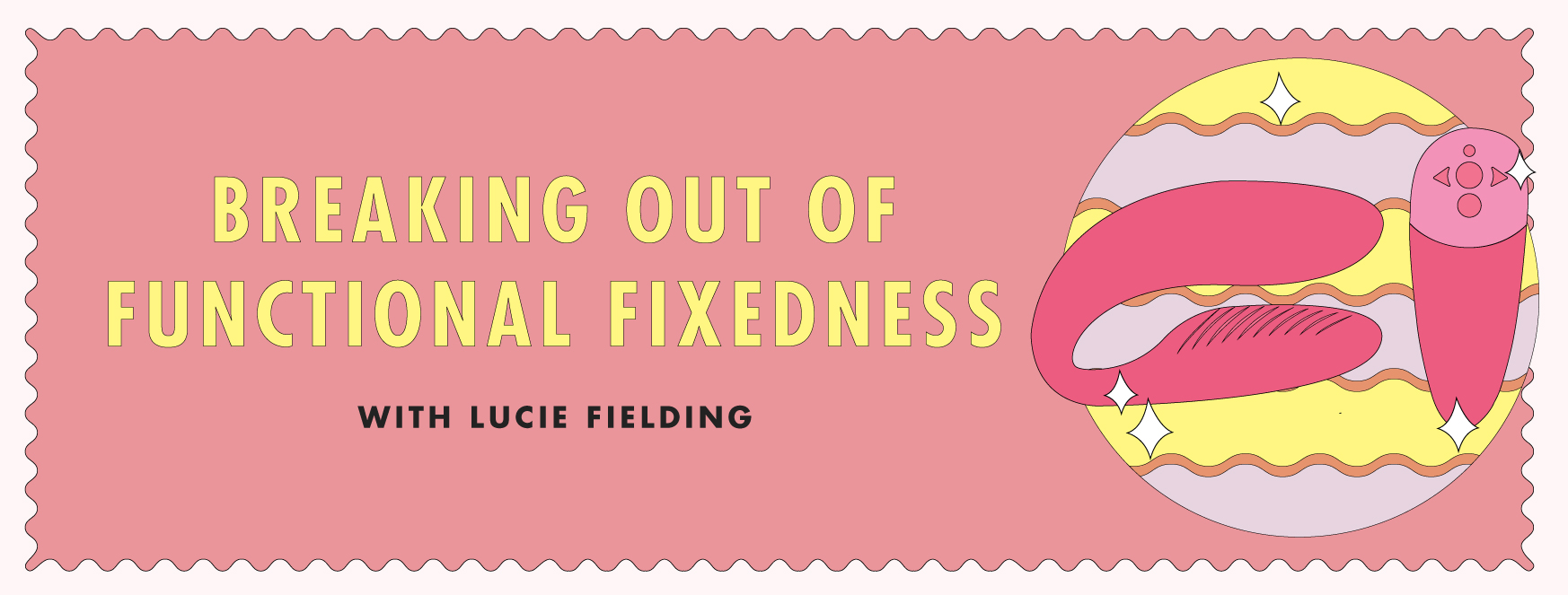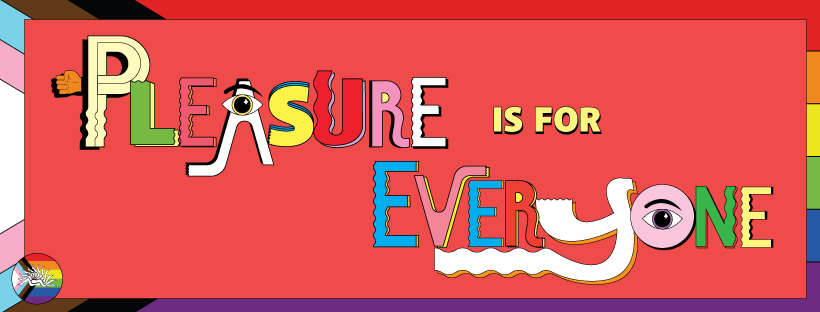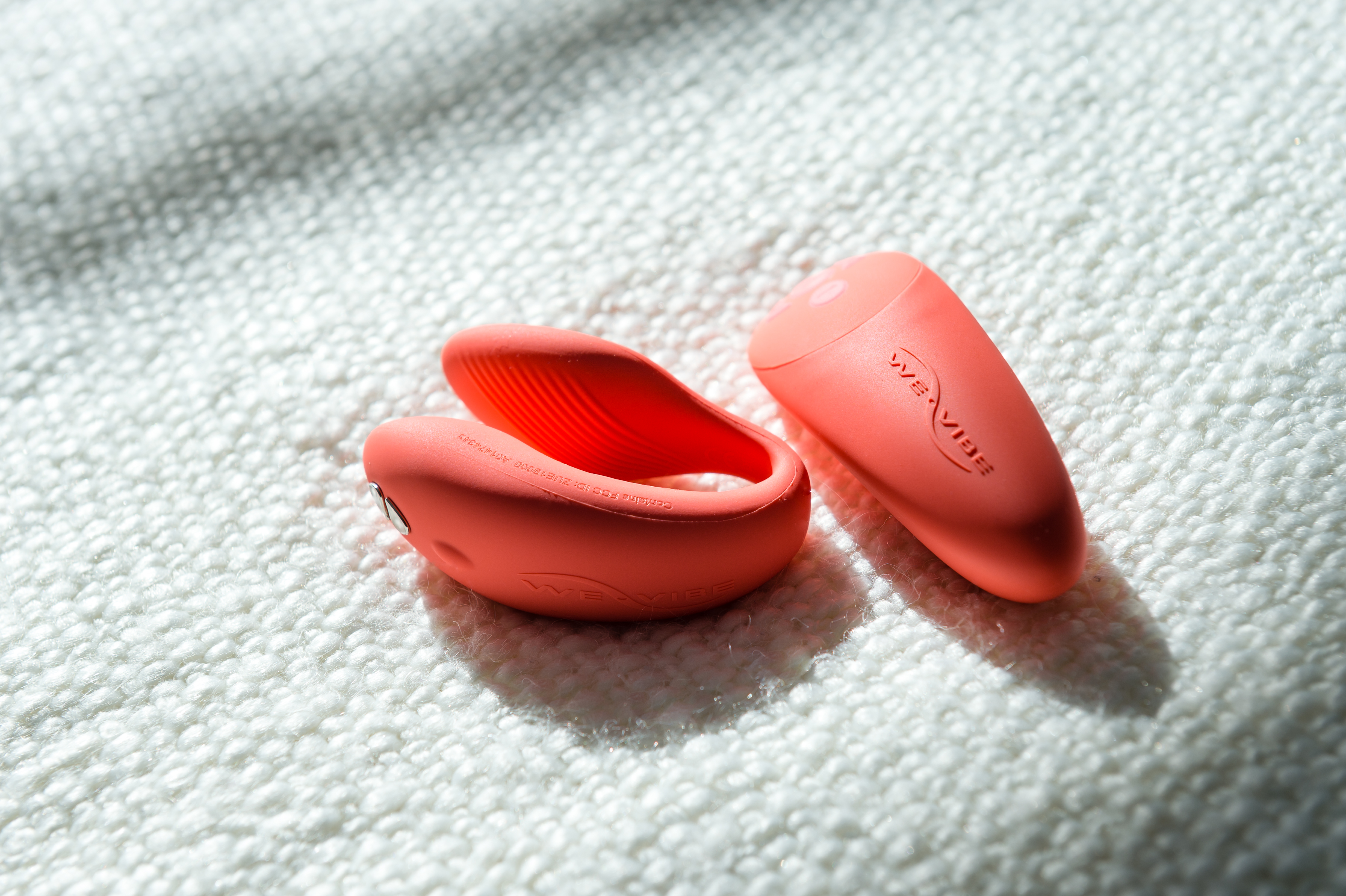THIS ENTRY WAS POSTED ON June 13, 2023 BY Lucie Fielding.

Oftentimes, when we encounter objects in the world, or even our bodies and the bodies of our partners, our first impulse may be to identify them as something we already know. Doing so imbues the object or body parts with histories and freights them with a host of feelings, meanings, and associations. Some of these feelings, meanings, and associations come to us through direct experience over time with a given object or part (or, more to the point, objects/parts of a similar general look and feel). Others come from stories transmitted to us by the cultures in which we move.
Ultimately, our experience and associations with objects and parts—and, I would argue, activities!—can limit our ability to engage in divergent thinking and use an object, interact with a body part, or engage in a given activity in ways that are imaginative, non-traditional, and perhaps revelatory and pleasure-enhancing. As the sex coach Susanna Brisk (2018) has noted, our prior experiences with objects and body parts (and especially certain “genital configurations”) all too often encourage us to “approach the new as if it were just an extension of the old.”
This is what happens, say, when we are having sex with someone and instead of asking about how and where we would like to be touched or checking in during play about intensities of touch (“faster or slower?” “harder or softer?” “do you want more of this touch?” “what would make this hotter?”) they simply charge ahead and do “that thing” they always do with their tongue. And then, to add insult to injury, they will often collapse breathless next to us and ask, “So, did you cum?” (or “So was it good for you, baby?”).
Blergh!
On Functional Fixedness
The gestalt psychotherapist Karl Duncker identified this phenomenon as a cognitive bias and referred to it as functional fixedness. As a concept, functional fixedness is most often applied to problem-solving with respect to objects. Duncker’s most infamous example involved asking subjects to attach a candle to a wall after having been supplied with a small box of thumb tacks, a box of matches, and a candle. Duncker observed that experiment subjects tended to attach the candle to the wall using either the tacks or the matches to melt the bottom of the candle. Participants were so “fixated” by the thumb tack box’s most habitual function—namely, as a container for tacks, that they didn’t think to empty it of tacks and use it as a candle sconce that could be, itself, tacked to the wall. They could not, in short, engage in “out of the box” thinking.
For a more erotically-charged example of functional fixedness at work we might consider the case of the We-Vibe Chorus.
The Chorus is characterized and categorized as a “couples toy.” We love to classify, categorize, and characterize things in the world. In the realm of sex toys there are toys for penises, toys for vulvas, and non-binary toys (which all seem to look like starfish or manta rays, incidentally!), and couples toys.
The problem with this seemingly insatiable compulsion to categorize, as the French theorist Michel Foucault argues, is that in doing so we are, often unconsciously, structuring how we organize, produce, consume, and relate to knowledge; or perceive, respond to, or interact with phenomena. Categorizing and classifying forecloses possibility and limits and delimits our imaginative horizons.
Out of the box, the Chorus in no way resists its classification as a couples toy. Indeed, the toy box even contains directions for how the toy is to be used via a series of illustrative panels, an instructional cartoon, as it were. In my favorite of these illustrations, the Chorus is shown in use: the bottom half, or arm, of the toy is inserted to a front hole, presumably so that this part can deliver sensation to the internal parts of the clitoris and the periurethral sponge (sometimes referred as the G-Spot); and the upper arm of the Chorus then “clamps” down so that it rests on the external parts of the vulva, delivering yummy sensation to the labia and glans of the clitoris. Finally, the image depicts a masc-of-center-presenting person with a penis (I’m not wishing to assume the figure’s gender identity) engaging in PIV (penis-in-vagina) sex with the penis sliding into the front hole of a fem-of-center presenting person and under the bottom arm of the Chorus, presumably, also increasing sensation by affording the person with the vulva a sense of fullness.
If this were all the Chorus could do I’d really have little use for it. Save for strap-on play, I don’t really engage in anything like PIV sex. But, as the sex educator Corey More has pointed out, the Chorus is far more versatile than the toy’s guidance and marketing would indicate! We-Vibe, you’re really selling this toy short!
Some “off-label” uses of the Chorus:
- Vibrating butt plug: The Chorus is meant to be flexible and has a yummy “hinge” that joins the two arms. If you open the toy up into an L-shape you suddenly have a flared based and a vibrating butt plug that might also deliver targeted sensation (through the newly created base) to the perineum.
- Strap-on play: Let’s say you have a front hole and you enjoy strap-on sex. Pop the Chorus in and clamp it down like the instructional cartoon suggests, but instead place a strap-on harness over your hole and enjoy the vibration as you strap your partner(s).
- Stroker: Got a penis, a clit, or bottom growth from T? Well, who is to say that you can’t use the Chorus as a stroker and deliver some yummy vibe-y sensation to those parts? I often use the Chorus this way with my clit (I refer to my parts as my clit).
- Targeted sensation: Who says that this toy needs to be used with a partner? Open up the Chorus and use one or more of the vibrating arms to deliver targeted sensation to whatever parts you’d like! Nipple stim anyone? Place it on your clit and use an insertable in your front or back hole such as one of my personal favorites, the NJoy Pure Wand!
The Stories Cultures Tell About Our Bodies and Sexualities
As I noted above, functional fixedness is most classically applied to how we use objects, but the logic of functional fixedness applies just as much to sexual activities, kink experiences, and our bodies! Our bodies and our erotic lives are constantly being bombarded by stories, images, cultural scripts. The cultures in which we move impose on us through these stories, images, and scripts, sexual and gender values systems that seek to define—and all too often impose moral meaning upon—specific ways our bodies “should” work, how parts “should” be used or interacted with, and what they can do. They also transmit very clear ideas about what makes a “good body,” what makes a “bad” or “unruly” body, what “good sex” is, what “bad sex” is, what is “too much” sex, what is “too little” sex, who deserves pleasure, and who gets to have their needs met (emotionally, sexually, etc.).
As such, we get habituated as to how our bodies, or particular parts of our bodies, are to be used, are to be interacted with, or how they function; and we become set in our ways about what sex is supposed to look or feel like and how we go about experiencing pleasure.
One of the most pernicious of these stories is one that insists that the only good (or optimally “functional”) penis is a hard one penetrating a hole (e.g., a back hole, a wet front hole, a mouth). Moreover, we are told that penises are to be touched or interacted with only in certain ways: stroked, pumped, jerked, or bobbed. This story is great for the pharmaceutical industry in peddling drugs to combat so-called “erectile dysfunction.” But it harms most everyone else by foreclosing our erotic horizons!
Wanna get let in on a secret? You can have mind-blowing erotic experiences with a soft cock! The nerve clusters and endings are still there; the engorgement of the erectile tissue just increases surface area that perhaps allows greater access to those nerve endings. You’re not broken if you can’t “get it up” or “keep it up”!

Breaking Out of Functional Fixedness
In what remains of this piece, I provide a few strategies and a number of examples on how to break out of functional fixedness and find pleasure in the body. Many of these strategies originate in queer and trans approaches to eroticism and erotic embodiment. This is because queer and trans folks are ingenious when it comes to sexual and erotic expression. We’ve had to be, for it’s not like the sex education available in the United States and many other countries takes into account queer and trans experiencing! We have had to troubleshoot, innovate, and be, as Bellwether put it so evocatively, “sexy mad scientists.” But even though these ideas arise from queer and trans experiencing, I think there is a lot for cis and straight folks to derive inspiration from!
- Re-Name Parts: Trans and non-binary folks have come up with an array of wonderfully clever and creative names for our various body parts! A few I’ve encountered over the years: gock, bussy, girl dick, t-dick, man cave, man hole, front hole, back hole, chesticles, junk, naughty bits. And we trans folks aren’t the only ones who have words/terms they especially like for their parts. How many cis women have strong feelings about words like “cunt” or “pussy”! Why re-name parts? Simply put, doing so can be a way of reclaiming a body part (especially chest tissue or genitals) that would otherwise be cloaked in dysphoria. It can also help signal partners how they might energetically interact with said body part.
- Consider Energies and Intentions Being Brought to Parts and Activities: One of my absolute favorite questions to ask in negotiating play with a partner is, “And how would you like to feel during our play?” If someone approaches me at a play party and says that they would like for me to spank them, the only things I know is that they are seeking to impact bottom and that they have identified me as an impact top who might be able to offer them a good spanking. But that’s about it. As my dear friend Princess Kali notes in the fabulous revised edition of her book on exploring erotic humiliation, Enough to Make You Blush (2023), any given sexual or kink activity can be approached in so many different ways and evoke a number of feeling states. So, to use my spanking example, I could spank them in such a way that they feel broken down and small or I can spank them in such a way that they feel competent, strong, and capable. This is to say that when considering play, we shouldn’t just think about what we want to do with a partner or what parts might be involved in said play, but also what types of energies and intentions we want to bring to an activity, to our bodies, and/or to our partner’s bodies. Attending to what Kali refers to as the kernel kink of play, namely the “core emotional aspect” of play or the goal energy you wish brought to your body during play, is the difference between navigating a dysphoria minefield and a yummy, affirming, gender-pleasurable erotic experience. Let’s take the example of oral sex (I’m grateful to my friend Jamie Joy for inspiring this example). If a partner is stuck in a functional fixedness place they may interact with my body in habitual ways, ways that treat my clit as if it is a penis that needs to be bobbed (or given a blow job). But if a partner is considering energies and intentions and engaging me in those considerations they are more likely to learn that I prefer my clit to be swirled rather than bobbed. And a fun, affirming time will be had by all!
- De-Center Genitalia and Chest Tissue: We can experience pleasure through multiple zones of our bodies and via all sorts of activities, not just through stimulation or involvement of chest tissue or our genitalia. I have experienced intense pleasure being trussed and tied in rope, having various parts of my body struck by impact toys, or while a knife’s edge warped and weaved across the surface of my skin. I have reached ecstatic heights of orgasmic delight after having gazed into a partner’s eyes and brought my breath in sync with theirs. And stimulation of numerous non-genital parts of my body through various forms of touch—a lover biting down hard on my collarbone, delivering hickies to my inner thighs or neck, meticulously sucking each of my fingers—have all offered me at times ecstasies beyond words. The point is this: our bodies are infinitely expandable and capable of experiencing pleasure in multiple ways. I often go so far as to describe our bodies as marvelously multifaceted, polymorphously perverse playgrounds of wonder!
Each of these strategies point to an essential truth and a core value, articulated magnificently by Mira Bellwether in Fucking Trans Women, “The form of someone’s body doesn’t necessarily determine what that body means, how it works, or what it can do.” Only we get to decide what our parts are called, what types of touch we enjoy, what energies and intentions being brought to our bodies feel most yummy and affirming, and where and how pleasure is experienced in our bodies. We are invited to approach our erotic selves and our erotic lives with a beginner’s mind and curiosity, and to dream and imagine into that which adrienne maree brown referred to as a “whole new landscape of pleasure” in the body. Boldly go where no one has gone before? Second star to the right, and straight on ‘till morning, friends!
Sensate Mapping Activity for Beginning to Break Out of Functional Fixedness
I’m a big fan of activities that help embody concepts and support integration. In order to help you experience what breaking out of functional fixedness can feel like, I’m pleased to provide you with an exercise I include in chapter 3 of my book, Trans Sex: Clinical Approaches to Trans Sexualities and Erotic Embodiments (Routledge, 2021): Sensate Mapping.
Sensate Mapping is an activity derived, in part, from the sex therapy modality of Sensate Focus and, in part, from the practices of somatic sex educators and sexological bodyworkers. The hope is that Sensate Mapping can begin to create the kind of imaginal space that is essential for breaking out of functional fixedness. In its purest form, Sensate Mapping consists of two rounds of three minutes each. There are two roles: the Cartographer and the Witness, and you and your partner would, ideally, switch roles after the first round.
What you’ll need: a set of objects, preferably small enough that they could be held comfortably in one hand. They can be any type of object, but perhaps the more mundane the objects the better.
Directions:
- Kindly invite the Cartographer to sit across from you and to assume a relaxed, comfortable seated pose, in their chair or on a couch or on a floor. Then, invite the Cartographer to close their eyes and hold out a hand.
- The Witness will now deposit an object into the Cartographer’s open hand.
- The Cartographer should be invited to bring their curiosity to the object and slowly interact with it however they are moved to do so, as long as their eyes remain closed and they confine touch on their body to the area between elbow and fingertips.
- Remind the Cartographer that they might be tempted to name and identify their object. This is a completely normal impulse. All the same, invite them to resist that identification process, or to engage in it but choose to ignore any identification that takes place. In this way, the hope is that they will begin interacting with the object without relying upon a process of comparison or identification that might encourage them to interact with their object in a set way.
- The Cartographer may choose to play with a single object for a long time or they may find that they get tired of mapping an object. In this case, they should be invited to hold out their hand to the Witness. The Witness will then remove the discarded object and place a new object in the Cartographer’s hand.
- Engage in this activity for 3 minutes and then process the experience together, using the questions that follow to structure that processing.
- If you began as a Witness then start the process over as a Cartographer for another 3-minute round. If you began as a Cartographer then start the process over as a Witness for the second 3-minute round.
Questions for the Cartographer:
- Were you able to ignore the impulse to identify the object(s) you were given?
- What did you learn as you interacted with and began to (re-)map the object(s)?
- What sensations, images, feelings, and thoughts might you have noticed bubbling up into awareness as you moved your hands over the object(s)?
- What was it like to be witnessed in your process?
Questions for the Witness:
- What was it like to witness the Cartographer in their process?
- What did you observe and what did you notice in yourself?
- What sensations, images, feelings, and thoughts came up for you as a Witness?
Lucie Fielding, PhD, MA, LMHC (she/they) is a queer, kinky, polyamorous, trans misogyny-affected (TMA) femme, and a therapist practicing in Virginia and Washington (on Monacan and unceded Duwamish land, respectively). In addition to being a therapist, Lucie is a sex educator and the author of Trans Sex: Clinical Approaches to Trans Sexualities and Erotic Embodiments (2021), which was named a 2022 Lambda Literary Award finalist (in the Transgender-Nonfiction category) and the winner of the 2022 AASECT Book Award (Book for Sexuality Professionals). You can find out more about Lucie at luciefielding.com or follow them on Instagram @sexbeyondbinaries.

